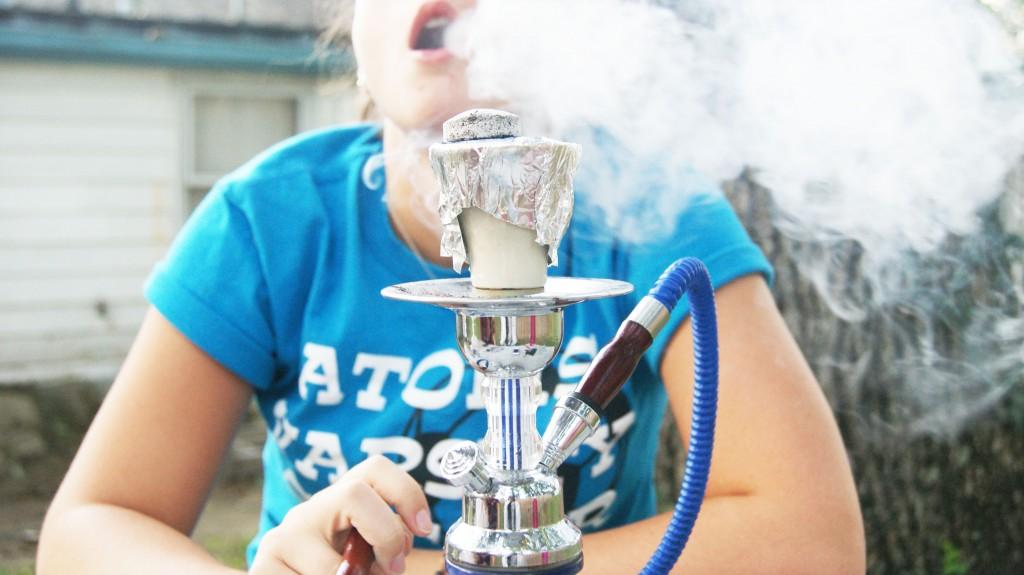Students have heard of them all before—tobacco, marijuana, smokeless tobacco—and know the several risks that using tobacco-based products can affect. Use of these products has decreased severely in the last decade, but the popularity of another has not: the hookah.
According to a recent survey conducted on 500 students (see page 7 for full results), about 76 percent of them have never used a tobacco-based product, including the hookah. Though this data proves that the student body hardly uses tobacco products, students are still smoking the hookah; most of the time doing it illegally.
Breathed out of a pipe with the makings of foreign tobaccos, honey molasses and dried fruit, the hookah’s surge in popularity among students stems back to its early Middle Eastern roots. The substance was originally used for relaxation, patience, and discipline, but now is commonly used for social gatherings at various bars found around different areas in the country. Many of these hookah bars lie right in the Northern Virginia and D.C. area, though there are many that fail to card students for the legal age of 18 to smoke it.
“I first started smoking hookah during my sophomore year in high school,” senior Julia Copenhaver said. “I would go with some friends on the weekend to select hookah bars that we knew wouldn’t ID us. After I turned 18, I decided to invest in my own personal ‘mini-hookah’ because it’s much more convenient and a lot cheaper in the long run in comparison to pricey hookah bars.”
Like Copenhaver, most students tend to smoke the hookah with friends either at a specialized bar or at parties with homemade pipes. Though the hookah’s popularity has increased among student social life, awareness of the downsides of the substance has not.
According to the Center for Disease Control and Prevention, while many hookah smokers may consider the substance less harmful than smoking cigarettes, smoking with hookah causes many of the same health risks as cigarettes, such as oral cancer, lung cancer, stomach cancer, cancer of the esophagus, reduced lung function, and decreased fertility.
The CDC even goes on to add that in many cases, smoking hookah can be even more dangerous than smoking cigarettes, for the smoke is inhaled longer, thus making more toxins enter the body in larger quantities. As it is commonly used in group settings, the mouthpiece of the hookah is more likely to hold many germs and diseases passed along from person to person as the pipe is used.
“Second-hand smoking from hookahs is worse than cigarettes or other tobacco substances,” health teacher Peggy Capehart said. “I’ve been to hookah bars for dinner, and the second-hand smoke is just too much to handle in there.”
“I usually [smoke hookah] like every month or every few months,” junior Lailumah Faisal said. “My sisters, who are a few years older than me, started going to hookah bars, and then eventually they got one and so we all started smoking it during special occasions—like whenever we had friends over or when we’d do bonfires or stuff like that.”
The origins of the hookah can be traced back nearly a millennia ago to the north western provinces of India along the border of Pakistan and was originally made with only one flavor. Today, there are nearly nine flavors that are used, some of them including watermelon and chocolate mint. Due to AHS’s diverse student population, the surge of participation in hookah-related activities can be directly related to the cultural backgrounds of students.
Unlike many students who started smoking hookah solely for social reasons, senior Brody El-Achi began using it originally for these cultural purposes.
“The first time I smoked [hookah] was in Lebanon because it is more socially acceptable over there,” El-Achi said. “It’s just a fun thing to do every now and then.”
Even knowing the risks that comes with smoking, several students still practice it; a lot of them priding themselves on their efforts to master the “tricks” of smoking hookah.
“I find it very relaxing and it’s fun to learn how to do tricks with the smoke,” Copenhaver said.
Due to the overall lack of student awareness, many health teachers believe that smoking hookah should be added to the health class curriculum and should be taught jointly with the risks of other tobacco-based products.
“[The risks of smoking hookah] should definitely be taught in health class,” Capehart said. “I really do [believe that].”









